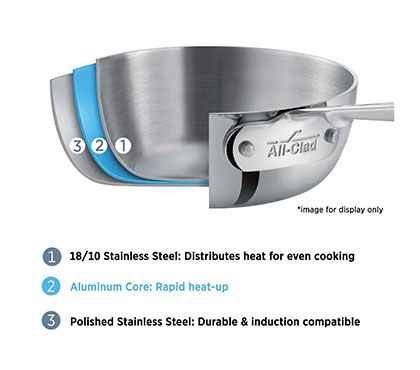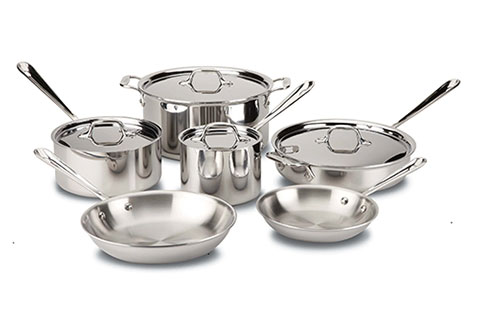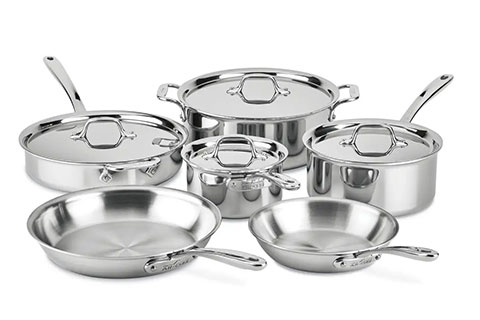D3, D5, Copper Core of G5 — see our guide from experience cooks to choose your right All-Clad.
By Editor Team | July 9, 2022

In This Review:
We love All-Clad. It heats incredibly evenly, gives fantastic results and lasts very long. But their pots and pans are expensive. Are they worth it? Why they’re that expensive? Are they made in the US? Which pieces are to pick in our collections? These questions are repeatedly asked, so we decided to find out deeper answers.
It starts in the 1960s where the technology of processing aluminum became cheaper and common for cookware. Aluminum is an excellent conductivity, but it’s highly reactive, too soft and easily distortion. While Calphalon and some others went to harden aluminum by anodizing process to work out this issue, John Ulam, a renowned metallurgist and avid home chef, successfully made his prototype cladded pan — aluminum bonded to stainless-steel — from unused supplies from his company, the Composite Metal Products, Inc.
The outcome is astonishing, so he started All-Clad Metalcrafters in 1971. Shortly after, he opened a factory near his hometown in Western Pennsylvania and ‘All-Clad’ had been recognized as a former and specialist in high-quality cladded cookware. After 2015, All-Clad is in custody of Groupe SEB.
Cladding is a method of metal fabrication by bonding layers of different metals — a conductive interior to improve heat distribution wrapping by a non-reactive exterior (mostly, stainless-steel) for food safety and enhanced durability — together to a new, single sheet of metal.
By harnessing the benefit properties of various metals, you’ll get cookware that dispenses heat evenly, gets more durability and has no flavors (or possible toxin) in your foods.

‘Ply’ means to the number of metal layers contained in a pan. For example, tri-ply (3-ply) has three layers usually contained a layer of copper or aluminum sandwiched between stainless steel.
However, a higher ply doesn’t always directly mean better. The total thickness and thermal conductivity of cladding materials impact heat performance to a larger degree than the number of layers contained within the cladded metal.
Commonly, cladding means Fully clad — like All-Clad cookware — that has a conductive material (s) runs from each rim to rim of a pan, allowing excellent heat distribution. While disc base (encapsulated or bonded base) only has a heat distributing disc in the bottom of the pan, which makes it less evenly but is cheaper.
We all know All-Clad is expensive. Something you need to know is not all clad cookware is created equal. These are why All-Clad is different (and more expensive) than others:
As made in the United States (for stainless-steel lines), it faces the higher cost of labor and regulations than China or most sub-contracted countries. However, in the other hand, this also ensures better quality control, quality materials and safety assurance. Chemical contamination and structural failure are no (or rarely) heard.
For both professional grade of materials and craftmanship, All-Clad is dependably superior. You might find All-Clad knockoffs out there, but few of them are better, or at least equal.
Their cookware is extremely robust and can reliably last for a lifetime. It also offers a lifetime warranty over factory defects.
Undoubtedly, this is the main reason we buy cookware. All-Clad brings unfailing results for any tasks, from boils to golden-brown sears.
So, we can tell: yes, it’s worth that hype. Especially, when you consider it as a long-term investment. All-Clad offers no-regret quality and lasts decades, so the annual cost is so low. Moreover, you’ll get rid of any nasty problems happened in most mediocre products — warps, broken handles, popping surfaces, dull surfaces or shattered lids — for an entire lifespan.
“The All-Clad signature & excellent multi-tasker”

D3 is definitely a trademark and best-selling line of All-Clad. With the total thickness at a 2.6mm and a 1.7mm aluminum layer inside, it gives substantial amount of heat control during cooking process — moderately-fast heat reaction and retention — and produces evenly results, without too-cumbersome weight to handle.
D3 isn’t the first rate on every facet (but far better than most 3-ply cookware in the market), however, it greatly gives a perfect balance of performance, durability, maneuverability and value.

Most home cooks displease the D3’s flat, hollow handles that feel uncomfortable to control. However, we can’t really place that this an unforgivable flaw. Many avid chefs, on the other hand, favor these handles for more practical to apply chef’s techniques that need to toss, tilt and pour a hot, a weighty pan in one hand.
Also, it has no pouring rims like upper lines but still has ideal shapes for functional cooking, for both pots and pans.
Home cooks who want a reliable cookware at the most worthwhile investment. Intermediate cooks who want to improve their cooking experiences or who wants to give All-Clad a shot.
“Solid performer with easier-than-ever usability”

Thumb up for All-Clad, D3 Everyday fixes D3’s blemishes while maintaining solid performance of the original D3. Some speculate that it’s made to fight back the popular DTC cookware — like Made In, Goldilocks, or Sardel — that gradually take D3’s steak. Whether or not, it definitely pampers home cooks due to the thoughtfully user-friendlier designs, which are more rounded, snugger handles, flared rims for drip-free pouring and interchangeable lids.
We think its assortment is more practical for daily routines. It contains wider-surfaced skillets (8.5” and 10.5”, instead of 8” and 10” in a normal set) and a multi-tasking 6-quart Dutch oven style, in place of old 8-quart stockpot. All-Clad didn’t say anything about the lowering price than D3 in some pieces, which might be just a promotion during our review period*.
It’s sold exclusively at All-Clad’s website. Additionally, you’ll get a smaller saucepan and a stockpot than D3.
Home cooks who love D3 quality but dislike their old handles and straight rims.
“The sear master & induction superiority”

D5 — 5-ply clad by alternating layers of stainless-steel and aluminum with the same thickness as D3 — heats up and cools down fairly slower but distributes temperature more evenly and retains heat fairly better than D3 and significantly longer than Copper Core. This delivers elevating searing and browning effects, with very less burnt spots. These extra layers of metal vastly boost sturdiness of the pan and makes super durable. No warp is found.
D5 is also promoted as an ideal for induction cooking, and we’ve found the same pleasing results on induction/electric ranges equivalent to gas stoves. Moreover, it offers improved ergonomic handles with bolsters (nicer than D3 and Copper Core but still not our favorable), rolled rims for easy pouring and wider lid handles.
D5 has two options: brushed and polished exterior — nothing triggers with the performance, just an aesthetic appearance.

As D5 — excluding the D7 (discontinued) — is the most indestructible line of All-Clad cookware, it’s heavy. This heft weight can be unwieldy or burden a small wrist when tossing or pouring foods. Also, it’s slightly more expensive than D3.
People who enjoy more gradually heat response — slowly heating but giving super evenly outcomes without frustrated of too fast and vigorous heating. And, those who cook on induction but want the same consistent results like on the gas.
“The speedy Ferrari”

Copper Core is a 5-ply clad, but a 0.9mm copper layer does make utterly different in heat specific. While D5 is slow but surely even, Coper Core is a fast player that reacts with the temperature considerably quickly. This character is a merit for recipes that requires a precise temperature control, such as delicate sauces, seafoods or sweets. It’s a nifty workhorse on induction, as well.
While D3 and most fully clad have a smaller cluster of boiling area in the center of the pan (on a gas ring), Copper Core can spread heat all over surface of the pan, which gives more even results without hot spots.
It has a fancier presence and upgraded handles, but a small stopper on the handles doesn’t trigger our ergonomic scores enough.

With a thin mass, Copper Core isn’t excellent at heat retention like D5 but in comparable to D3. More importantly, if you don’t really need the high thermal responsiveness and super evenness or are unfamiliar to control this nimble Ferrari, it mightn’t be worth the hype cost, almost twice the price of D3.
Not a foible, owing to its too thin copper, the thermal agility isn’t in the same league with real copper cookware. However, with unfussy maintenance and lighter weight, it’s a competent arsenal, indeed.
Experienced cooks or people who expect for the speed up and precisely temperature control for the upper-skilled recipes. Or those who want a touch of copper performance but don’t want to pamper their pots and pans.
“The lightweight & swift innovator”

This new face — a winner of 2021 Popular Science Best, What’s New Award — is a 5-ply clad with an innovation conductive core, pyrolytic graphite, claiming for 80% lighter, hotter and faster than copper.
G5 works as advertised as heating up lightning-fast, distributing temperature steadily and giving nearly immediate temperature control. It effortlessly delivers crusty, golden-brown filets, perfect fries and jump sautés, hasty preheat and boil, as well as effective reduces. Plus, with enough grease, it surprisingly leaves less burnt crumbs than other stainless-steel pans and less mess to clean up.
Apparently, a most amazing thing is the incredible lightweight — this is now the lightest line of All-Clad stainless cookware, overtaking the Copper Core. And, with the more comfortable, stay-cool handles, G5 should be favorable for small people or those with weak wrists.

Like Copper Core, you might need some experience or skills to control this swift and hotter thermal change for preventing your foods from getting scorches.
Except for the limited offering (only 4 pieces available now) that sold by All-Clad’s website only, G5 is as expensive as Copper Core. The 3-quart sauté pan is $325*, comparing with $180* of D3 and $300* of D5 at the same size.
People who need super-speedy thermal shift for fish filets, delicate sauces, caramels, and some certain deserts. And someone who are very weight-conscious or small-wrist cooks who need comfortably light, solid and performance pots and pans.
All-Clad declared that all of the fully bonded cookware and bakeware are manufactured in the USA with US suppliers providing the metals. This means all vessels of stainless-steel collections currently — D3, D5, Copper Core and G5 — are supposed to made at their Canonsburg factory, at Pennsylvania.
However, some single-layer products, such as lids and handles, are allowed to make outside the country. Also, the impact-bonded, hard-anodized nonstick lines (like HA1, B1 and Essential) and tools, accessories or electrical kitchen appliances are sourced outside, mostly from China.
Commonly, stainless-steel cookware is dishwasher safe — All-Clad, too. However, even if their stainless-steel lines are labeled ‘dishwasher-safe’, an updated affirmation from the company is: handwashing with a mild soap and soft sponge is recommended to keep it looking brand-new because high heat and harsh detergent in the dishwasher can damage the surface of cookware.
There’re some discontinued collections, like Master Chef 2 (MC2), that aren’t induction safe. However, most of their collections can work with most stovetops and ovens, including induction.
Say, the stainless-steel collections that are induction-ready now are D3, D5, Copper Core and G5, while the nonstick lines are B1, HA1, NS1 and Fusion Tech.
Yes. All-Clad has one of the finest honoring lifetime warranties in the market. Except for nonstick lines, the company indorses their cookware and bakeware and will repair and replace any cookware that shows evidence of manufacturing defects without charge. See the full warranty conditions.
Before buying, ask yourself: what do you buy it for? This will make easier to decide which pieces to choose or if it really worth the budget. For a clearer picture, we’ve roughly summarize the main characteristics of each collection of All-Clad stainless-steel, as follows.

Before going further, there is a thing to keep in mind: when we rank a collection a lower (or lowest), this does NOT mean it’s poor or substandard than other players in the market. Keep in mind that all All-Clad’s products are made professionally quality and far better beyond most cookware out there.
Our comparison chart — a better or worse — means by assessment among the all-clad products only. For example, when we said d5 is slower to heat up, this means it’s slower than other lines but not for other contenders that D5 might be faster.

Each collection has its different characteristic. These are common scenarios for a supportive decision.
If you don’t know where to begin, consider D3 — it’s all-around good. Most home cooks are likely to cook regular and healthy meals and rarely go for advanced techniques, D3 is enthusiastically good to fulfil the daily task in a reasonable cost.
You can choose D3 Everyday over D3 for the reason of more comfortable handles and pouring rims, at a same price range.
A key to perfect searing is a metal (not nonstick) pan that survives high heat, distributes temperature evenly and retains heat well. If you pick stainless-steel pans, which cooks more evenly than cast-iron skillets (top10 cast iron skillet), any All-Clad stainless pans are solid sear masters.
For regular home chefs, D3 and D5 are admirably sufficient for searing tasks, but D5 let your work easier. D5 heats gradually but holds temperature better so it gives entire steaks more consistently, no drastic brown, overcook, or scorched outcomes. It also creates perfect fonds and deglazes at ease, even if you’re a beginner.
Skilled chefs might favor Copper Core and G5 as giving faster and hotter results. However, since all of them gives the beautiful sears eventually, D3 and D5 are considered more cost-effective.
If you’re hype for the precise thermal control or need significantly sudden thermal change, consider G5 and Copper Core.
More importantly, unlike D3 and most fully clad that have a smaller cluster of bubbly area in the center of the pan, Copper Core and G5 can distribute heat steadily across the entire surface of the pan, which brings a perfect, even simmer with no hot spots. If you rave for restaurant-quality sauces, risottos or caramelly chocolates, which needs both quick and super steady heating, they’re worth the hype. The 2.5-quart G5 Toss & Sauce Pan (a saucier-shaped pan) is good to consider.
If weight is a most concern, G5 is clearly the best bet. However, if you look for a more value option, consider D3. It’s a bit more heavy but still handy for moving around.
Due to a thinner construction, copper Core vessels in fact weigh slightly lighter than D3. However, since Copper Core has extended long handles and often has a helper handle, some pieces (such as a 12” skillet or 3-quart sauté pan) are heavier while some small-sized pieces (like a 2 quart saucepan or 8” skillet) are a bit lighter or equivalent to D3.